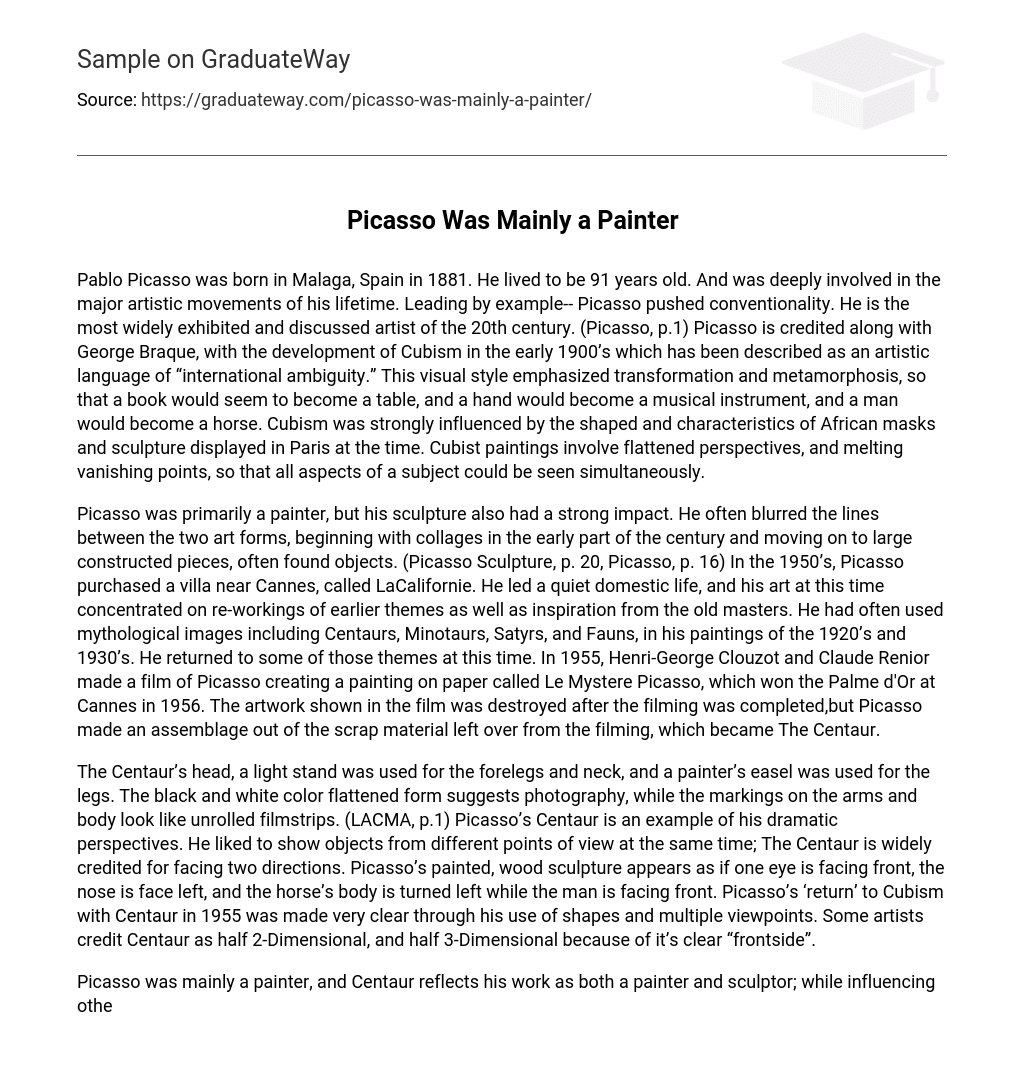Pablo Picasso was born in Malaga, Spain in 1881. He lived to be 91 years old. And was deeply involved in the major artistic movements of his lifetime. Leading by example– Picasso pushed conventionality. He is the most widely exhibited and discussed artist of the 20th century. (Picasso, p.1) Picasso is credited along with George Braque, with the development of Cubism in the early 1900’s which has been described as an artistic language of “international ambiguity.” This visual style emphasized transformation and metamorphosis, so that a book would seem to become a table, and a hand would become a musical instrument, and a man would become a horse. Cubism was strongly influenced by the shaped and characteristics of African masks and sculpture displayed in Paris at the time. Cubist paintings involve flattened perspectives, and melting vanishing points, so that all aspects of a subject could be seen simultaneously.
Picasso was primarily a painter, but his sculpture also had a strong impact. He often blurred the lines between the two art forms, beginning with collages in the early part of the century and moving on to large constructed pieces, often found objects. (Picasso Sculpture, p. 20, Picasso, p. 16) In the 1950’s, Picasso purchased a villa near Cannes, called LaCalifornie. He led a quiet domestic life, and his art at this time concentrated on re-workings of earlier themes as well as inspiration from the old masters. He had often used mythological images including Centaurs, Minotaurs, Satyrs, and Fauns, in his paintings of the 1920’s and 1930’s. He returned to some of those themes at this time. In 1955, Henri-George Clouzot and Claude Renior made a film of Picasso creating a painting on paper called Le Mystere Picasso, which won the Palme d’Or at Cannes in 1956. The artwork shown in the film was destroyed after the filming was completed,but Picasso made an assemblage out of the scrap material left over from the filming, which became The Centaur.
The Centaur’s head, a light stand was used for the forelegs and neck, and a painter’s easel was used for the legs. The black and white color flattened form suggests photography, while the markings on the arms and body look like unrolled filmstrips. (LACMA, p.1) Picasso’s Centaur is an example of his dramatic perspectives. He liked to show objects from different points of view at the same time; The Centaur is widely credited for facing two directions. Picasso’s painted, wood sculpture appears as if one eye is facing front, the nose is face left, and the horse’s body is turned left while the man is facing front. Picasso’s ‘return’ to Cubism with Centaur in 1955 was made very clear through his use of shapes and multiple viewpoints. Some artists credit Centaur as half 2-Dimensional, and half 3-Dimensional because of it’s clear “frontside”.
Picasso was mainly a painter, and Centaur reflects his work as both a painter and sculptor; while influencing other sculptors to push the boundaries of art. A Centaur itself is mythical, but Picasso had no trouble abtrastifying the subject. Centaur is unrealistic: with interlocking planes, and different perspectives. Picasso was never taught to sculpt, therefore his take on it was very different from painting. Centaur is one of his most unique, and influential contributions to sculpture given its material: wood. Picasso was inspired by Ancient Greek mythology: where Centaurs were first viewed. Infact, Ancient Greece is credited to have inspired Picasso’s ‘Classical Art’ period. Picasso’s development as an artist, and invention of Cubism acclaims him one of the most influential artists. Centaur is a rare example of a Cubist sculpture, from Picasso in the 20th Century– a purposeful emphasis on geometrical shapes and distortment. (Koroxenidis, Ancient Greece, a Steady Influence in the Unique Art of Pablo Picasso)





